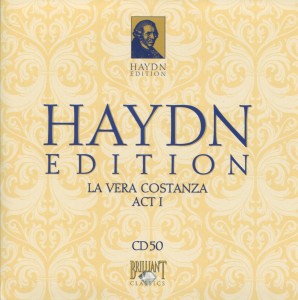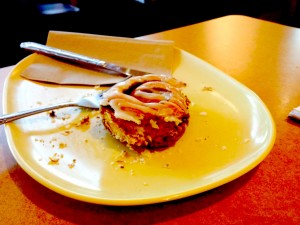 Today’s CD is La Vera Costanza (no relation to George, I’m sure). It is an opera in three acts, with Libretto by Francesco Puttini, published in 1785. Haydn was 53.
Today’s CD is La Vera Costanza (no relation to George, I’m sure). It is an opera in three acts, with Libretto by Francesco Puttini, published in 1785. Haydn was 53.
This morning, I’m listening to Act I.
And I liked it from the first few notes.
In fact, all of Sinfonia was delightful, as was the follow-up: Menuetto. Haydn’s orchestral music is magical. Track 3 (“Introduzione: Che burrasca, che tempest”) gives us a preview of the voices and the storyline. (By the way, as near as I can figure, “Che burrasca, che tempest” is Italian for “That storm, that tempest.”)
Here’s the cast and a couple of the musicians featured in this Brilliant Classics recording:
Rosina: Ingrid Kappelle soprano
Baroness: Ellen van Haaren soprano
Lisetta: Maja Roodveldt soprano
Count: Albert Bonnema tenor
Masino: Frank Fritschy tenor
Ernesto: Rein Kolpa tenor
Villotto: Julian Hartman bass
Catharijne Consort violin?
Frank van Koten
The first think I notice about the cast is that there are a lot of tenors and sopranos. If the stage is what movies and TV crack it up to be, the drama amongst all of those singers must have been incredible.
Tempest, indeed.
The second thing I notice — after doing a Google search of their names — is that nearly all of them have web sites in Dutch only. From a marketing perspective, I strongly encourage them to offer their web sites in English or offer to translate into other languages once on the home page. The Dutch audience is large, and very loyal. But if they want to be known outside of their native countries, they really need to think globally. And that starts by representing themselves in English.
 I also just noticed that I eat a cinnamon roll all around the rings, leaving the inner part — the “filet of cinnamon roll” — for the end. Hmmm. I wonder if that’s normal.
I also just noticed that I eat a cinnamon roll all around the rings, leaving the inner part — the “filet of cinnamon roll” — for the end. Hmmm. I wonder if that’s normal.
For that matter, is it even normal to be undertaking a three-year exploration without a single day’s break?
I’ll ponder that whilst I eat my filet of cinnamon roll.
On to the music…
Let’s turn to Wikipedia to see what this opera is about, shall we?
La vera costanza (“True Constancy”), Hob. 28/8, is an operatic dramma giocoso by Joseph Haydn. The Italian libretto was a shortened version of the one by Francesco Puttini set by Pasquale Anfossi for the opera of the same name given in Rome in 1776. The story explores the troubles of a sentimental heroine abandoned by a mad lover.
“Dramma Giocoso“? Let’s see what “dramma giocoso” means:
Dramma giocoso (Italian, literally: jocular drama; plural: drammi giocosi) is the name of a genre of opera common in the mid-18th century. The term is a contraction of “dramma giocoso per musica” and is essentially a description of the text rather than the opera as a whole. The genre developed in the Neapolitan opera tradition, mainly through the work of the playwright Carlo Goldoni in Venice. Characteristic of drammi giocosi is the technique of a grand buffo scene as a dramatic climax at the end of an act. Carlo Goldoni’s texts always consisted of two long acts with extended finales, followed by a short third act.
A “jocular drama.” That sounds like what I’m listening to. It may be a dramatic story. But the music and the vocals are tinged with lightness and a bit of sly humor.
Track 7 (“Aria: So che una bestia sei”) features a very nice performance by tenor Frank Fritschy. He has a very clear voice with great range.
Another very fine performance is found in Track 11 (“Aria: Io son poverina”) featuring soprano Maja Roodveldt.
Another standout track is No. 14 (“Aria: A trionfar t’invita”) featuring tenor Albert Bonnema. The music is terrific and the vocals are remarkable.
Another noteworthy track: No. 15 (“Aria: Con un tenero sospiro”) featuring soprano Ingrid Kapelle.
I can see that my pattern is arias. I seem to love solo performances in which the vocalists can show off their talents.
The penultimate track of Act I — No. 18 (“Finale: Ah che divenni stupida”) — is terrific. It’s brash, vibrant, and just plain fun.
Here. Listen for yourself. Below is the entire opera, exactly the performances I’ve heard this morning. Don’t cheat, though. Only listen through the end of Act I (about 1:02:53 on the clip).
We’ll pick up Acts II and III tomorrow.
Okay? Promise me. No listening ahead — or I’ll send you to bed with no filet of cinnamon roll.
